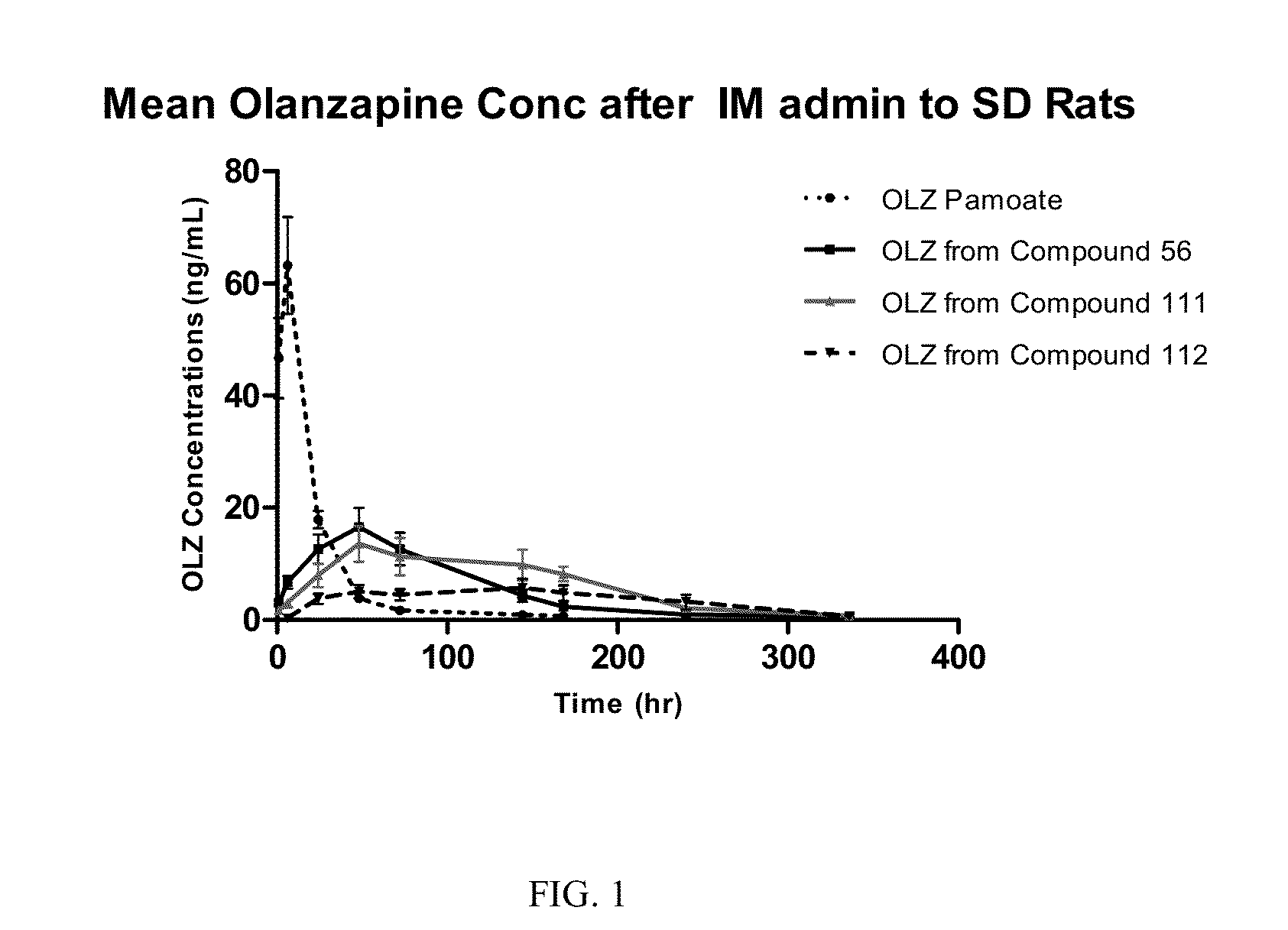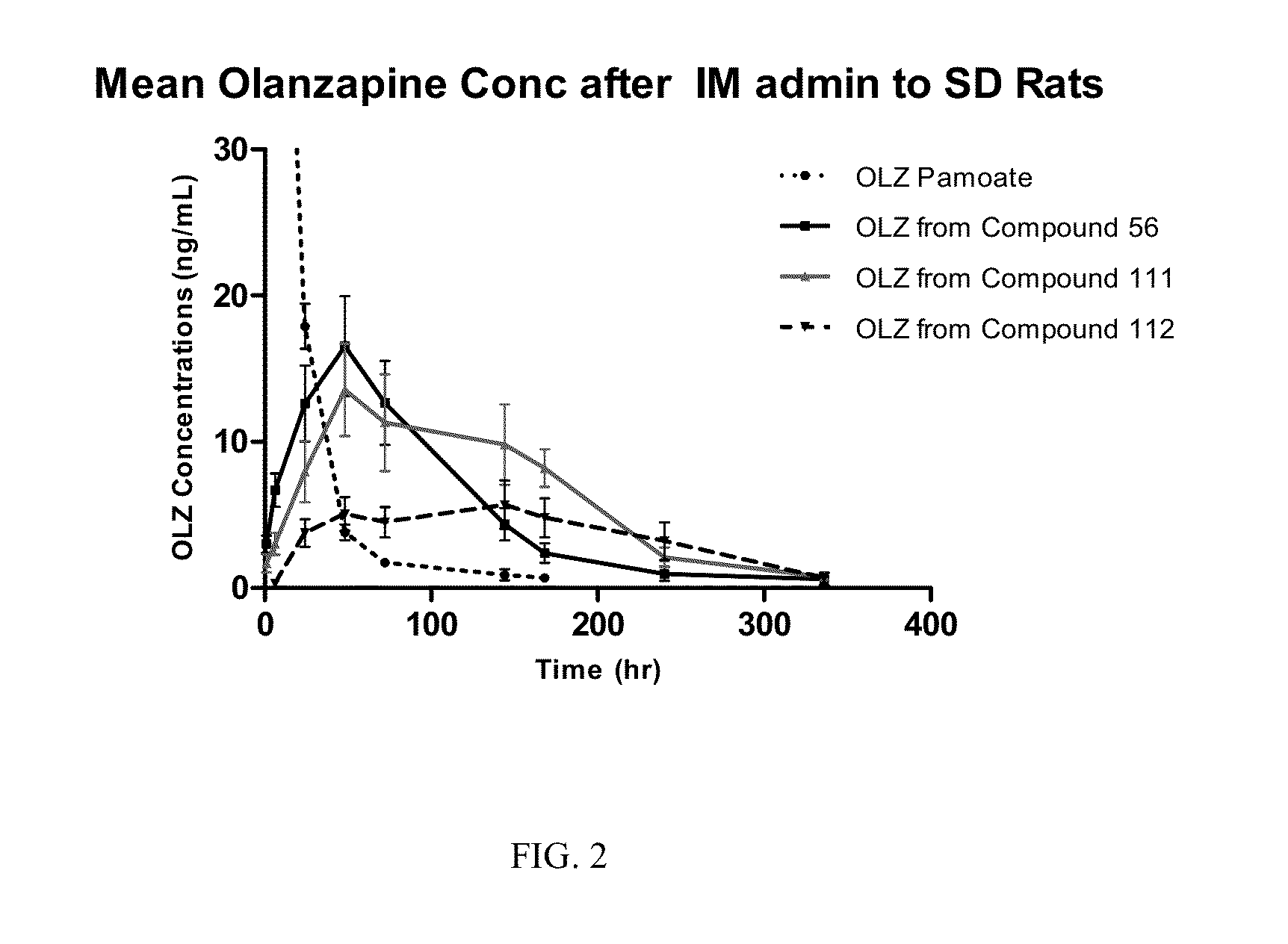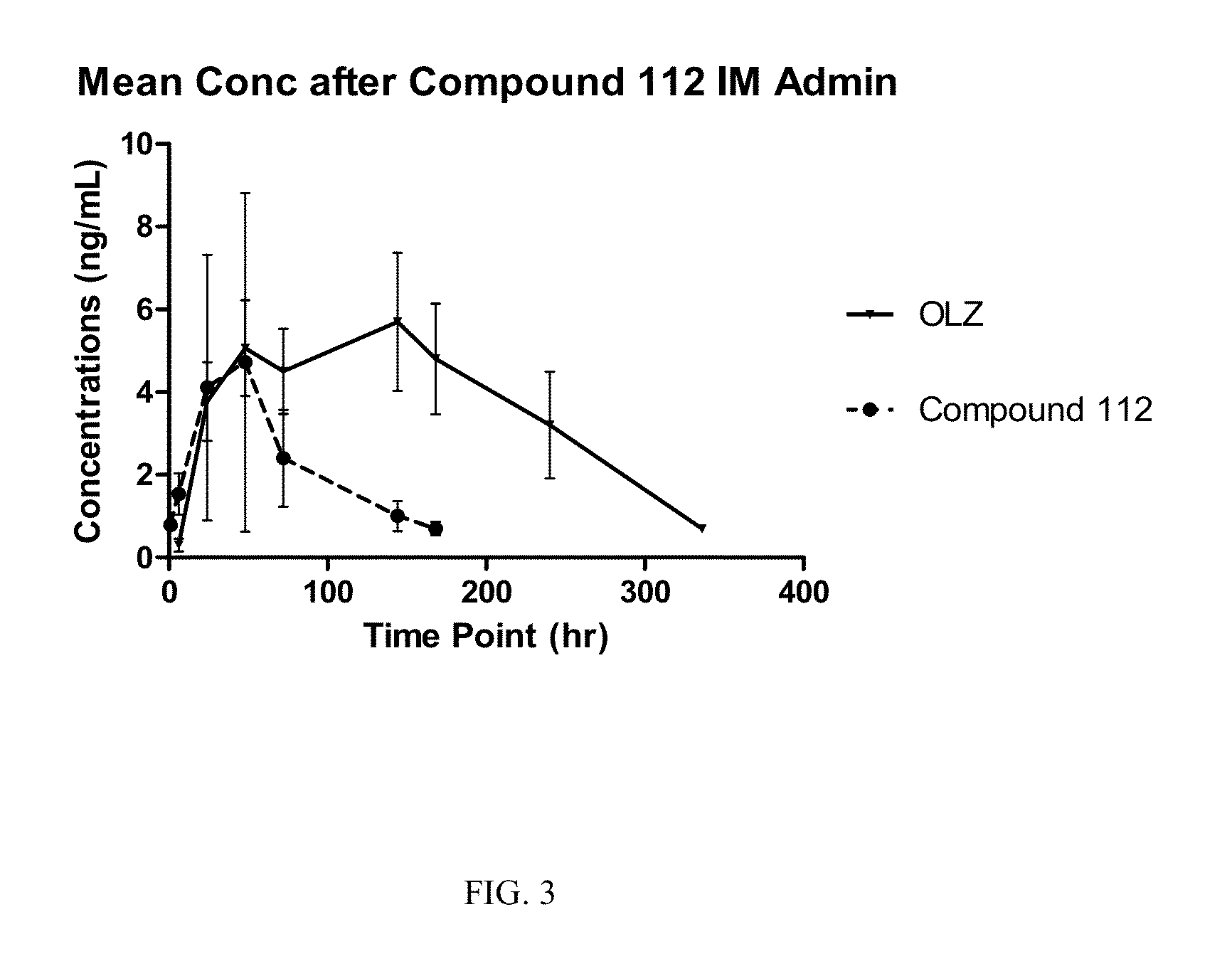Prodrugs of Secondary Amine Compounds
a technology of amine compounds and prodrugs, which is applied in the direction of drug compositions, immunological disorders, metabolism disorders, etc., can solve the problems of unreliable control of the degradation process required for the release of active agents, not all of these drugs have pharmacokinetic properties, and complicate dosage reproducibility, so as to reduce the risk of patients, reduce the solubility and polarity of the prodrug compound, and prolong the effect of action
- Summary
- Abstract
- Description
- Claims
- Application Information
AI Technical Summary
Benefits of technology
Problems solved by technology
Method used
Image
Examples
example 1
(tetradecanoyloxy)methyl 2-methyl-4-(4-methylpiperazin-1-yl)-5H-benzo[b]thieno[2,3-e][1,4]diazepine-5-carboxylate (Compound 127)
[0154]Synthesis of chloromethyl 2-methyl-4-(4-methylpiperazin-1-yl)-5H-benzo[b]thieno[2,3-e][1,4]diazepine-5-carboxylate [A]:
[0155]To a solution of olanzapine (18.0 g, 57.7 mmol) and triethylamine (16 mL, 0.12 mol) in dichloromethane (250 mL) was warmed to 35° C. and once a clear solution formed, the reaction was cooled to 5 OC. To this was added chloromethyl chloroformate (7.6 mL, 86.5 mmol) over 20 minutes. The reaction was stirred at room temperature for 30 min and allowed to warm to room temperature. After 15 min at room temperature the reaction mixture was diluted with dichloromethane (100 mL), then washed with aq satd NaHCO3 (75 mL) and water (350 mL). The organic phase was dried over MgSO4 and filtered. The organic phase was then concentrated under vacuum at 45° C. to a volume of ˜150 mL. The mixture was diluted with ethyl acetate (30 mL) and ˜20-30 ...
example 2
(palmitoyloxy)methyl 2-methyl-4-(4-methylpiperazin-1-yl)-5H-benzo[b]thieno[2,3-e][1,4]diazepine-5-carboxylate (Compound 56)
[0160]Using the procedure as described above for (octanoyloxy)methyl 2-methyl-4-(4-methylpiperazin-1-yl)-5H-benzo[b]thieno[2,3-e][1,4]diazepine-5-carboxylate except heated at 60° C. for 1 day gave (palmitoyloxy)methyl 2-methyl-4-(4-methylpiperazin-1-yl)-5H-benzo[b]thieno[2,3-e][1,4]diazepine-5-carboxylate Compound 56 (1.51 g, 75%) as a yellow oil.
[0161]1H-NMR (300 MHz, CDCl3) δ 7.62-7.55 (1H, m), 7.45-7.21 (2H, m), 7.17-7.08 (1H, m), 6.26-6.20 (1H, m), 5.66-5.35 (2H, m), 3.90-3.79 (2H, m), 3.68-3.54 (2H, m), 2.47-2.45 (4H, m), 2.33-2.24 (8H, m), 1.61-1.50 (2H, m), 1.35-1.15 (24H, m), 0.92-0.81 (3H, m).
example 3
(stearoyloxy)methyl 2-methyl-4-(4-methylpiperazin-1-yl)-5H-benzo[b]thieno[2,3-e][1,4]diazepine-5-carboxylate (Compound 111)
[0162]Using the procedure as described above for (octanoyloxy)methyl 2-methyl-4-(4-methylpiperazin-1-yl)-5H-benzo[b]thieno[2,3-e][1,4]diazepine-5-carboxylate gave (stearoyloxy)methyl 2-methyl-4-(4-methylpiperazin-1-yl)-5H-benzo[b]thieno[2,3-e][1,4]diazepine-5-carboxylate Compound 111 (1.51 g, 75%) as a yellow oil.
[0163]1H-NMR (300 MHz, CDCl3) δ 7.63-7.54 (1H, m), 7.46-7.37 (1H, m), 7.36-7.26 (1H, m), 7.18-7.07 (1H, m), 6.28-6.19 (1H, m), 5.67-5.56 (1.5H, m), 5.38-5.34 (1H, m), 3.91-3.78 (2H, m), 3.69-3.54 (2H, m), 2.50-2.40 (4H, m), 2.31-2.24 (6H, m), 1.61-1.50 (2H, s), 1.34-1.20 (30H, m), 0.87 (3H, t). [M+H]+=653.14.
PUM
 Login to View More
Login to View More Abstract
Description
Claims
Application Information
 Login to View More
Login to View More - R&D
- Intellectual Property
- Life Sciences
- Materials
- Tech Scout
- Unparalleled Data Quality
- Higher Quality Content
- 60% Fewer Hallucinations
Browse by: Latest US Patents, China's latest patents, Technical Efficacy Thesaurus, Application Domain, Technology Topic, Popular Technical Reports.
© 2025 PatSnap. All rights reserved.Legal|Privacy policy|Modern Slavery Act Transparency Statement|Sitemap|About US| Contact US: help@patsnap.com



